(Copyright - Java[at]Saindra - 2010)
About Christmas
- Posted: 12/25/2008 11:36:00 am
- |
- Author: Java[at]Saindra
- |
- Filed under: Ceremonial, christmas, information
 Christmas (IPA: /krɪsməs/), occasionally referred to as Christmas Day or Christmastide, is an annual Christian holiday celebrated on December 25 or January 7[2] that marks and honors the birth of Jesus of Nazareth.[3][4] The nativity of Jesus, which is the basis for the anno Domini system of dating, is thought to have occurred between 7 and 2 BC.[5] December 25 is not thought to be Jesus' actual date of birth, and the date may have been chosen to correspond with either a Roman festival,[6] or with the winter solstice.[7] Modern customs of the holiday include gift-giving, church celebrations, and the display of various decorations—including the Christmas tree, lights, mistletoe, nativity scenes and holly. Santa Claus (also referred to as Father Christmas, although the two figures have different origins) is a popular mythological figure often associated with bringing gifts at Christmas. Santa is generally believed to be the result of a syncretization between Saint Nicholas and elements from pagan Nordic and Christian mythology, and his modern appearance is believed to have originated in 19th century media.
Christmas (IPA: /krɪsməs/), occasionally referred to as Christmas Day or Christmastide, is an annual Christian holiday celebrated on December 25 or January 7[2] that marks and honors the birth of Jesus of Nazareth.[3][4] The nativity of Jesus, which is the basis for the anno Domini system of dating, is thought to have occurred between 7 and 2 BC.[5] December 25 is not thought to be Jesus' actual date of birth, and the date may have been chosen to correspond with either a Roman festival,[6] or with the winter solstice.[7] Modern customs of the holiday include gift-giving, church celebrations, and the display of various decorations—including the Christmas tree, lights, mistletoe, nativity scenes and holly. Santa Claus (also referred to as Father Christmas, although the two figures have different origins) is a popular mythological figure often associated with bringing gifts at Christmas. Santa is generally believed to be the result of a syncretization between Saint Nicholas and elements from pagan Nordic and Christian mythology, and his modern appearance is believed to have originated in 19th century media.Christmas is celebrated throughout the Christian population, but is also celebrated by many non-Christians as a secular, cultural festival. Because gift-giving and several other aspects of the holiday involve heightened economic activity among both Christians and non-Christians, Christmas has become a major event for many retailers.
More information About Christmas :
- Also called : Christ's Mass, Nativity, Yule Tide, Noel, Xmas, Winter Pascha
- Observed by : Christians, Many non-Christians[1]
- Type : Christian, cultural
- Significance : Nativity of Jesus
- Date : December 25 (Western Christianity), January 6 (Armenian Apostolic Church), January 7 (several Eastern Orthodox Churches)
- Observances : Religious services, gift giving, family meetings, decorating trees
- Related to : Annunciation, Advent, Epiphany, Baptism of the Lord, Winter solstice
Admin of Java[at]Saindra says :
Marry Christmas..!! Thursday, December 25th 2008 God Bless You All.. Java[at]Saindra
Etymology
History
Winter Festivals
A winter festival was the most popular festival of the year in many cultures. Reasons included the fact that less agricultural work needs to be done during the winter, as well as an expectation of better weather as spring approached.[13] Modern Christmas customs include: gift-giving and merrymaking from Roman Saturnalia; greenery, lights, and charity from the Roman New Year; and Yule logs and various foods from Germanic feasts.[14] Pagan Scandinavia celebrated a winter festival called Yule, held in the late December to early January period. As Northern Europe was the last part to Christianize, its pagan traditions had a major influence on Christmas. Scandinavians still call Christmas Jul. In English, the word Yule is synonymous with Christmas,[15] a usage first recorded in 900.
Dies Natalis Solis Invicti
Dies Natalis Solis Invicti means "the birthday of the unconquered Sun." The use of the title Sol Invictus allowed several solar deities to be worshipped collectively, including Elah-Gabal, a Syrian sun god; Sol, the god of Emperor Aurelian; and Mithras, a soldiers' god of Persian origin.[16] Emperor Elagabalus (218–222) introduced the festival, and it reached the height of its popularity under Aurelian, who promoted it as an empire-wide holiday.[17] This day had held no significance in the Roman festive calendar until it was introduced in the third century.[18]
The festival was placed on the date of the solstice because this was on this day that the Sun reversed its southward retreat and proved itself to be "unconquered." Several early Christian writers connected the rebirth of the sun to the birth of Jesus.[4] "O, how wonderfully acted Providence that on that day on which that Sun was born...Christ should be born", Cyprian wrote.[4] John Chrysostom also commented on the connection: "They call it the 'Birthday of the Unconquered'. Who indeed is so unconquered as Our Lord . . .?"[4]
Patristic Development
The New Testament does not give a date for the birth of Jesus.[19][4] Around AD 200, Clement of Alexandria wrote that a group in Egypt celebrated the nativity on Pachon 25.[4] This corresponds to May 20.[20] Tertullian (d. 220) does not mention Christmas as a major feast day in the Church of Roman Africa.[4] In Chronographai, a reference work published in 221, Sextus Julius Africanus suggested that Jesus was conceived on the spring equinox.[21] The equinox was March 25 on the Roman calendar, so this implied a birth in December.[22] De Pascha Computus, a calendar of feasts produced in 243, gives March 28 as the date of the nativity.[23] In 245, the theologian Origen of Alexandria stated that, "only sinners (like Pharaoh and Herod)" celebrated their birthdays.[24] In 303, Christian writer Arnobius ridiculed the idea of celebrating the birthdays of gods, which suggests that Christmas was not yet a feast at this time.[4]
Feast Established
The earliest reference to the celebration of the nativity on December 25 is found in the Chronography of 354, an illuminated manuscript compiled in Rome in 354.[25] In the East, early Christians celebrated the birth of Christ as part of Epiphany (January 6), although this festival focused on the baptism of Jesus.[26]
Christmas was promoted in the Christian East as part of the revival of Catholicism following the death of the pro-Arian Emperor Valens at the Battle of Adrianople in 378. The feast was introduced to Constantinople in 379, and to Antioch in about 380. The feast disappeared after Gregory of Nazianzus resigned as bishop in 381, although it was reintroduced by John Chrysostom in about 400.[4]
Middle Ages
In the Early Middle Ages, Christmas Day was overshadowed by Epiphany, which in the west focused on the visit of the magi. But the Medieval calendar was dominated by Christmas-related holidays. The forty days before Christmas became the "forty days of St. Martin" (which began on November 11, the feast of St. Martin of Tours), now known as Advent.[27] In Italy, former Saturnalian traditions were attached to Advent.[27] Around the 12th century, these traditions transferred again to the Twelve Days of Christmas (December 25 – January 5); a time that appears in the liturgical calendars as Christmastide or Twelve Holy Days.[27]
The prominence of Christmas Day increased gradually after Charlemagne was crowned Emperor on Christmas Day in 800. King Edmund the Martyr was anointed on Christmas in 855 and King William I of England was crowned on Christmas Day 1066.
By the High Middle Ages, the holiday had become so prominent that chroniclers routinely noted where various magnates celebrated Christmas. King Richard II of England hosted a Christmas feast in 1377 at which twenty-eight oxen and three hundred sheep were eaten.[27] The Yule boar was a common feature of medieval Christmas feasts. Caroling also became popular, and was originally a group of dancers who sang. The group was composed of a lead singer and a ring of dancers that provided the chorus. Various writers of the time condemned caroling as lewd, indicating that the unruly traditions of Saturnalia and Yule may have continued in this form.[27] "Misrule" — drunkenness, promiscuity, gambling — was also an important aspect of the festival. In England, gifts were exchanged on New Year's Day, and there was special Christmas ale.[27]
Christmas during the Middle Ages was a public festival that incorporating ivy, holly, and other evergreens.[28] Christmas gift-giving during the Middle Ages was usually between people with legal relationships, such as tenant and landlord.[28]
In Colonial America, the Puritans of New England disapproved of Christmas. Celebration was outlawed in Boston from 1659 to 1681. At the same time, Christian residents of Virginia and New York observed the holiday freely. Pennsylvania German Settlers, pre-eminently the Moravian settlers of Bethlehem, Nazareth and Lititz in Pennsylvania and the Wachovia Settlements in North Carolina, were enthusiastic celebrators of Christmas. The Moravians in Bethlehem had the first Christmas trees in America as well as the first Nativity Scenes. Christmas fell out of favor in the United States after the American Revolution, when it was considered an English custom.[30] George Washington attacked Hessian mercenaries on Christmas during the Battle of Trenton in 1777. (Christmas being much more popular in Germany than in America at this time.) By the 1820s, sectarian tension had eased and British writers, including William Winstanly began to worry that Christmas was dying out. These writers imagined Tudor Christmas as a time of heartfelt celebration, and efforts were made to revive the holiday. Charles Dickens's book A Christmas Carol, published in 1843, played a major role in reinventing Christmas as a holiday emphasizing family, goodwill, and compassion as opposed to communal celebration and hedonistic excess.[31] In America, interest in Christmas was revived in the 1820s by several short stories by Washington Irving which appear in his The Sketch Book of Geoffrey Crayon and "Old Christmas", and by Clement Clarke Moore's 1822 poem A Visit From St. Nicholas (popularly known by its first line: Twas the Night Before Christmas).[32] Irving's stories depicted harmonious warm-hearted holiday traditions he claimed to have observed in England. Although some argue that Irving invented the traditions he describes, they were widely imitated by his American readers. The poem A Visit from Saint Nicholas popularized the tradition of exchanging gifts and seasonal Christmas shopping began to assume economic importance.[33] In reaction, this also started the cultural conflict of the holiday's spiritualism and its commercialism that some see as corrupting the holiday. In her 1850 book "The First Christmas in New England", Harriet Beecher Stowe includes a character who complains that the true meaning of Christmas was lost in a shopping spree.[34] Christmas was declared a United States Federal holiday in 1870, signed into law by President Ulysses S. Grant.
Nativity of Jesus
Remembering is a central way that Christians celebrate Christmas. There is a very long tradition of the Nativity of Jesus in art. The Eastern Orthodox Church practices the Nativity Fast in anticipation of the birth of Jesus, while much of the Western Church celebrates Advent. In some Christian denominations, children perform plays re-telling the events of the Nativity, or sing carols that reference the event. Some Christians also display a small re-creation of the Nativity, known as a Nativity scene, in their homes, using figurines to portray the key characters of the event. Live Nativity scenes and tableaux vivants are also performed, using actors and live animals to portray the event with more realism.[37]
Nativity scenes traditionally include the Three Wise Men, Balthazar, Melchior, and Caspar, although their names and number are not referred to in the Biblical narrative, who are said to have followed a star, known as the Star of Bethlehem, found Jesus, and presented gifts of gold, frankincense, and myrrh.[38] The including of the Magi in the nativity would be in conflict with the Biblical account, as it indicates that they found Jesus approximately two years after his birth, rather than on the exact day (Matt. 2:7–8, 16).
In the U.S., Christmas decorations at public buildings once commonly included Nativity scenes. This practice has led to many lawsuits, as groups such as the American Civil Liberties Union believe it amounts to the government endorsing a religion, which is prohibited by the United States Constitution. In 1984, the U.S. Supreme Court ruled in Lynch vs. Donnelly that a Christmas display (which included a Nativity scene) owned and displayed by the city of Pawtucket, Rhode Island did not violate the First Amendment.[39]
Santa Claus and Other Bringers of Gifts
The popular image of Santa Claus was created by the German-American cartoonist Thomas Nast (1840–1902), who drew a new image annually, beginning in 1863. By the 1880s, Nast's Santa had evolved into the form we now recognize. The image was standardized by advertisers in the 1920s.[40]
Father Christmas, who predates the Santa Claus character, was first recorded in the 15th century, but was associated with holiday merrymaking and drunkenness.[41] In Victorian Britain, his image was remade to match that of Santa. The French Père Noël evolved along similar lines, eventually adopting the Santa image. In Italy, Babbo Natale acts as Santa Claus, while La Befana is the bringer of gifts and arrives on the eve of the Epiphany. It is said that La Befana set out to bring the baby Jesus gifts, but got lost along the way. Now, she brings gifts to all children. In some cultures Santa Claus is accompanied by Knecht Ruprecht, or Black Peter. In other versions, elves make the toys. His wife is referred to as Mrs. Claus.
It is often claimed that the basis for the North American figure of Santa Claus is the Dutch holyman and bringer of gifts Sinterklaas. During the American War of Independence the inhabitants of New York City, a former Dutch colonial town (New Amsterdam) which had been swapped by the Dutch for other territories, reinvented their Sinterklaas tradition, as Saint Nicholas was a symbol of the city's non-English past.[42] The name Santa Claus supposedly is derived from older Dutch Sinte Klaas. However, the Saint Nicholas Society was not founded until 1835, almost half a century after the end of the American War of Independence.[43] Moreover, a study of the "children's books, periodicals and journals" of New Amsterdam by Charles Jones revealed no references to Saint Nicholas or Sinterklaas.[44] However, not all scholars agree with Jones's findings, which he reiterated in a booklength study in 1978;[45] Howard G. Hageman, of New Brunswick Theological Seminary, maintains that the tradition of celebrating Sinterklaas in New York was alive and well from the early settlement of the Hudson Valley on.[46]
The current tradition in several Latin American countries (such as Venezuela and Colombia) holds that while Santa makes the toys, he then gives them to the Baby Jesus, who is the one who actually delivers them to the children's homes. This story is meant to be a reconciliation between traditional religious beliefs and modern day globalization, most notably the iconography of Santa Claus imported from the United States.
In Alto Adige/Südtirol (Italy), Austria, Czech Republic, Southern Germany, Hungary, Liechtenstein, Slovakia and Switzerland, the Christkind (Ježíšek in Czech, Jézuska in Hungarian and Ježiško in Slovak) brings the presents. The German St. Nikolaus is not identical with the Weihnachtsman (who is the German version of Santa Claus). St. Nikolaus wears a bishop's dress and still brings small gifts (usually candies, nuts and fruits) on December 6 and is accompanied by Knecht Ruprecht. Although many parents around the world routinely teach their children about Santa Claus and other gift bringers, some have come to reject this practice, considering it deceptive.[47]
Decorations
Since the 19th century, the poinsettia, a native plant from Mexico, has been associated with Christmas. Other popular holiday plants include holly, mistletoe, red amaryllis, and Christmas cactus. Along with a Christmas tree, the interior of a home may be decorated with these plants, along with garlands and evergreen foliage.
In Australia, North and South America, and to a lesser extent Europe, it is traditional to decorate the outside of houses with lights and sometimes with illuminated sleighs, snowmen, and other Christmas figures. Municipalities often sponsor decorations as well. Christmas banners may be hung from street lights and Christmas trees placed in the town square.[52]
In the Western world, rolls of brightly colored paper with secular or religious Christmas motifs are manufactured for the purpose of wrapping gifts. The display of Christmas villages has also become a tradition in many homes during this season. Other traditional decorations include bells, candles, candy canes, stockings, wreaths, and angels.
In many countries a representation of the Nativity Scene is very popular, and people are encouraged to compete and create most original or realistic ones. Within some families, the pieces used to make the representation are considered a valuable family heirloom.
Christmas decorations are traditionally taken down on Twelfth Night, the evening of January 5.
The traditional colours of Christmas are pine green (evergreen), snow white, and heart red.
Christmas Stamps
In 1898 a Canadian stamp was issued to mark the inauguration of the Imperial Penny Postage rate. The stamp features a map of the globe and bears an inscription "XMAS 1898" at the bottom. In 1937, Austria issued two "Christmas greeting stamps" featuring a rose and the signs of the zodiac. In 1939, Brazil issued four semi-postal stamps with designs featuring the three kings and a star of Bethlehem, an angel and child, the Southern Cross and a child, and a mother and child.
The US Postal Service regularly issues both a religious-themed and a secular-themed stamp each year.
In most areas, Christmas Day is the least active day of the year for business and commerce; almost all retail, commercial and institutional businesses are closed, and almost all industries cease activity (more than any other day of the year). In England and Wales, the Christmas Day (Trading) Act 2004 prevents all large shops from trading on Christmas Day. Scotland is currently planning similar legislation. Film studios release many high-budget movies in the holiday season, including Christmas films, fantasy movies or high-tone dramas with high production values.
An economists analysis calculates that Christmas is a deadweight loss under orthodox microeconomic theory, due to the surge in gift-giving. This loss is calculated as the difference between what the gift giver spent on the item and what the gift receiver would have paid for the item. It is estimated that in 2001 Christmas resulted in a $4 billion deadweight loss in the U.S. alone.[54][55] Because of complicating factors, this analysis is sometimes used to discuss possible flaws in current microeconomic theory. Other deadweight losses include the effects of Christmas on the environment and the fact that material gifts are often perceived as white elephants, imposing cost for upkeep and storage and contributing to clutter.[56]
Books
- Christmas in America: A History, by Penne L. Restad (New York: Oxford University Press, 1995). ISBN 0-19-509300-3
- The Battle for Christmas, by Stephen Nissenbaum (1996; New York: Vintage Books, 1997). ISBN 0-679-74038-4
- The Origins of Christmas, by Joseph F. Kelly (August 2004: Liturgical Press) ISBN 978-0814629840
- Christmas Customs and Traditions, by Clement A. Miles (1976: Dover Publications) ISBN 978-0486233543
- The World Encyclopedia of Christmas, by Gerry Bowler (October 2004: McClelland & Stewart) ISBN 978-0771015359
- Santa Claus: A Biography, by Gerry Bowler (November 2007: McClelland & Stewart) ISBN 978-0771016684
- There Really Is a Santa Claus: The History of St. Nicholas & Christmas Holiday Traditions, by William J. Federer (December 2002: Amerisearch) ISBN 978-0965355742
- St. Nicholas: A Closer Look at Christmas, by Jim Rosenthal (July 2006: Nelson Reference) ISBN 1418504076
- Just say Noel: A History of Christmas from the Nativity to the Nineties, by David Comfort (November 1995: Fireside) ISBN 978-0684800578
- 4000 Years of Christmas: A Gift from the Ages, by Earl W. Count (November 1997: Ulysses Press) ISBN 978-1569750872
- The Birth of Christ", by Peter Sammons (May 2006: Glory to Glory Publications) (UK) ISBN 0-9551790-1-7
This post powered by :

copyright - javaatsaindra.blogspot.com - OSC
Green Computing
- Posted: 12/24/2008 12:10:00 pm
- |
- Author: Java[at]Saindra
- |
- Filed under: green computing, information, tips and trick, wisdom word
 Green Computing? Cikal bakal Green Computing dimulai pada tahun 1992. Saat itu US Environmental Protection Agency merelease program Energy Star, yaitu program promosi dan penghargaan bagi penerap efisiensi energi pada teknologi monitor, pengontrol iklim, dan teknologi lain. Istilah Green Computing muncul dengan booming-nya Energy Star ini, khususnya merujuk ke bagaimana kita bisa efisien dalam konsumsi energi pada penggunaan produk computing. Landasan pergerakannya adalah kebutuhan akan economic viability (keberlangsungan hidup), social responsibility (tanggung jawab sosial) dan environmental impact (pengaruh lingkungan). Para peneliti mengurai definisi Green Computing dengan sudut pandang yang sedikit berbeda. Kita bisa lihat dari beberapa di bawah:
Green Computing? Cikal bakal Green Computing dimulai pada tahun 1992. Saat itu US Environmental Protection Agency merelease program Energy Star, yaitu program promosi dan penghargaan bagi penerap efisiensi energi pada teknologi monitor, pengontrol iklim, dan teknologi lain. Istilah Green Computing muncul dengan booming-nya Energy Star ini, khususnya merujuk ke bagaimana kita bisa efisien dalam konsumsi energi pada penggunaan produk computing. Landasan pergerakannya adalah kebutuhan akan economic viability (keberlangsungan hidup), social responsibility (tanggung jawab sosial) dan environmental impact (pengaruh lingkungan). Para peneliti mengurai definisi Green Computing dengan sudut pandang yang sedikit berbeda. Kita bisa lihat dari beberapa di bawah:How to use your computer more sustainably (Young Yi)
Information technology that is environmental friendly and energy efficient (Wachara Chantatub)
The study and practice of using computing resources efficiently (Rawan M. Al-Ghofaili)
Reduce the increasing amount of useless data/work (Jordi Torres)
Yang menarik bahwa laporan Gartner tentang 10 teknologi strategis tahun 2008 (10 most strategic technologies for 2008), menempatkan isu teknologi Green Computing di nomor urut pertama. Tentu kalau kita mau analisa lebih dalam, dari 10 teknologi tersebut, SOA dan Web 2.0 tetap mendominasi, meskipun terpecah di aspek misalnya Business Process Modeling, Metadata Management, Virtualization 2.0, Mashup & Composite Apps, Web Platform & WOA dan Social Software. Mungkin sedikit saya rangkumkan tentang laporan Gartner Group ini sebagai berikut:
- Green IT: Fokus ke mengurangi konsumsi listrik, jumlah carbon footprint dan melakukan efisiensi energi dan kerja
- Unified Communications: Konsentrasi ke migrasi PBX ke VoIP
- Business Process Modeling: Era baru setelah UML, Use Case Diagram tidak mencukupi untuk menggambarkan business process yang lebih kompleks. Business Process Modeling Notation (BPMN) dan berbagai approach mulai bermunculan
- Metadata Management: Khususnya teknologi enterprise untuk manajemen data produk dan pelanggan. Bagian penting dari SOA.
- Virtualization 2.0: Ketika virtualisasi adalah utilisasi server dan implementasi aplikasi, virtualisasi 2.0 akan membantu kita mengarahkan kekuatan teknologi untuk proses otomasi yang lebih sempurna.
- Mashup & Composite Apps: Mashups and composite applications akan menghubungkan intranet korporasi bergaya Web 2.0 dengan internet publik. Diramalkan gartner akan mendominasi model pengembangan aplikasi enterprise mulai tahun 2010.
- Web Platform & WOA: Kombinasi dari Software as a service (SaaS) dan SOA akan menghasilkan Web Oriented Architecture (WOA). Kadang disebut juga dengan istilah cloud computing
- Computing Fabric: Ambil beberapa server blade, koneksikan semuanya dengan intelligent interconnect, dan tampilkan dalam bentuk single operating system image. Itulah “computing fabric“. Tren akan terus berkembang di era ke depan.
- Real World Web: Peralatan GPS yang semakin bervariasi dan built-in pada PDA, handphone dan iPhone akan membuat banyak perusahaan bisa memberikan layanan (aplikasi dan data) kepada kita sesuai dengan lokasi kita saat ini
- Social Software: Aplikasi social networking akan menuju ke enterprise dan internet korporasi
TIPS GREEN COMPUTING
Berikut adalah beberapa tips Green Computing dari aspek technical sampai strategis:
1. Green Computing on PC
- Laptop hanya memerlukan 10% energi yang digunakan Desktop. Flat screen hanya menggunakan 30% energi yang digunakan oleh Monitor CRT
- Coba upgrade RAM, sebelum memutuskan ganti komputer. Komputer lambat bisa karena kotornya registry atau ada background services yang berjalan padahal sebenarnya tidak kita perlukan. Cek dan matikan services yang sedang berjalan padahal tidak perlu itu. Misalnya untuk Windows jalankan Start > Run > type “msconfig”
- Menggunakan PC dan printer dengan merk dan jenis sama memudahkan kanibalisme dan proses recycle
- Matikan komputer ketika tidak digunakan (malam hari). Mematikan komputer akan mengurangi umur komputer adalah mitos yang salah
- Screen saver is not energy saver. Pilih matikan monitor daripada menggunakan screen saver
- Pilih virtualisasi daripada pembelian hardware baru (hemat 70% energi)
- Pilih peripheral berlogo energy star
- Catat bahwa mode power menentukan prosentase hemat energi (Sleep mode - hemat 70% energi, Standby mode - hemat 90% energi, Hibernate mode - hemat 98% energi)
- Jangan cepat membuang PC, lakukan recycle atau donasi ke pihak lain apabila sudah tidak digunakan
2. Green Computing on Laptop
- Gunakan power saving setting
- Kurangi penggunaan backlight
- Atur layar dan harddisk sleep/off setelah beberapa menit tanpa penggunaan
- Matikan bluetooth dan wifi ketika tidak digunakan
- Lepas kartu MMC, SD, USB Flash apabila tidak digunakan
- Kecilkan volume suara dan kontras layar
- Minimalisir penggunaan IrDA (infrared) atau serial communication, karena boros energi
- Upgrade RAM sebelum ganti laptop
- Jangan cepat membuang Laptop, lakukan recycle atau donasi ke pihak lain apabila sudah tidak digunakan
3. Green Computing on Paperless Method
Usahakan menggunakan paperless method untuk berbagai urusan kita karena itu mengurangi sampah carbon footprint. Apabila memungkinkan kembangkan dan terapkan Document Management System, Electronic Invoicing dan Electronic Business Process pada institusi kita.
4. Green Computing on Paperless Education
- Hindari kertas, gunakan file elektronik or blog untuk pengumpulan laporan dan tugas
- Lupakan cara konvensional, gunakan eLearning System untuk penyebaran modul ajar, forum diskusi dan assesment
- Gunakan Chatting dan Social Networking untuk mendukung pembelajaran. Ingat bahwa chatting untuk pacaran or godain orang, are not Green Computing!
5. Green Computing on Paperless Branding and Marketing
- Lupakan kartu nama, CV, koran dan majalah untuk personal branding
- Lakukan blogging untuk personal branding, marketing, bisnis bahkan influencing people
- Manfaatkan google sebagai kurir dan salesman kita dalam marketing dan branding
Dan akhirnya saya ucapkan selamat ber - Green Computing - ria, karena pada dasarnya semua orang dapat memahami serta melakukan dengan baik daripada Green Computing ini beserta implementasinya dari berbagai sudut pandang ![]()
REFERENSI
- Green Computing, Science Tech Entrepreneur, November 2007
- Green Computing Guide, http://www.uoregon.edu/~recycle/GreenComputing/GreenCompGuide_text.htm
- Green Computing, http://en.wikipedia.org/wiki/Green_computing
- University of Oregon Green Computing Guide, http://www.uoregon.edu:80/~recycle/Conservation_computing_text.htm
- Gartner Identifies the Top 10 Strategic Technologies for 2008, Gartner Symposium and IT Expo, October 7-12, 2007, Orlando
This post powered by:

copyright - javaatsaindra.blogspot.com - OSC
Love Word
"When I said I'd love you forever... I LIED... Forever is not enough.
--Andrew Crabtree
"When someone loves you- the way they say your name is different. You'll know your name is safe in their mouth.
--Unknown
"Love is what keeps you going when you want to give up!
--Irina Kopkov
"Love is not an option. Love just happens.
--Yvonne
"Love is a beautiful thing when you find the right person.
--Nastassja Borrero
copyright - javaatsaindra.blogspot.com - OSC
![]()
Youth Never Comes Again
- Posted: 12/22/2008 08:28:00 pm
- |
- Author: lil_bulbul
- |
- Filed under: wisdom word
copyright - javaatsaindra.blogspot.com - OSC
11 Bizarre Hotels That Will Knock Your Socks Off
- Posted: 12/21/2008 05:34:00 pm
- |
- Author: Java[at]Saindra
- |
- Filed under: hotels, informasi, information
Here is a sordid collection of places you can visit around the world with a variety of price ranges. These joints will surely take your travel stories and adventures to new levels.
United States

Beckham Creek Cave Haven
Located in the Ozarks (Arkansas), you can spend the night in this is natural living cave. (I saw other cave accommodations in my search for the bizarre and exciting, but this one seems to be the real deal as opposed to being blasted out).
The pictures look spectacular, and you are surely staying in the lap of luxury here. Or at least the lap of a big dark hole.
Average cost: $1,000

Dog Bark Park Inn
I’m not sure what else there is to see in Cottonwood Idaho, but this place surely is tops on the list. The owners (dog lovers – can you tell?) built the world’s largest beagle to be the bed & breakfast joint for you to write home about. It’s a friendly looking dog and all, but I can’t help but be reminded of the Trojan Horse. At the very least, it brings new meaning to “sleeping in the dog house”.
Average cost: $100
Jules’ Undersea Lodge
Located in the scuba diving Mecca of Key Largo, Florida, this hotel caters to a niche market: scuba divers. Exclusively.
You have to scuba dive to the front door of this hotel, 21feet under the sea. It is the original undersea lodge, as others have cropped up here and there since this innovative place was built. Built - or sunk, depending on how you look at it.

Jules’ Undersea Lodge
They offer underwater wedding packages, and “limited room service” (duh – they have to scuba dive it in!). But the real hook for me: “unlimited diving”; I should hope so!
Average cost: $350+
Canada
Ice Hotel
Just in case anybody living in warmer climes was wondering, Canadians don’t live in igloos! But here at the Ice Hotel in Quebec, Canada, they do. It is absolutely amazing what you can do with walls and furniture when you aren’t relegated to boring materials like drywall and plaster. The construction of the Ice Hotel changes each year, and is truly art. Everything – absolutely everything – is made of ice.
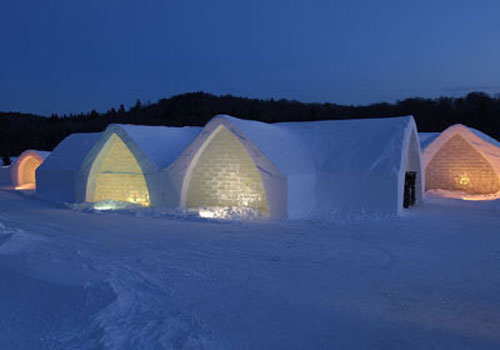
They say it’s surprisingly warm inside, but I can’t help but think that sleeping on a giant block of ice isn’t exactly toasty. It’s only open from January through March (when it starts to melt), so space fills up quickly.
Average cost: $300-475, but you can find promotions for as little as $150
Japan
Asakusa Capsule Hotel
We all know the Japanese are years ahead of North America in terms of wackiness, and they’re a little short on space too. Couple these two facts, and you have the Asakusa Capsule Hotel.

It looks more like a submarine than anything else; absolutely miniscule capsules stacked on top of one another for rooms. They cater to budget travelers (you aren’t exactly paying for a lot of space), and on the site they say “single travelers welcome”. That’s good, because I don’t think you could fit a party of two in there, no matter how well they know each other.
Rooms come complimentary with a panic button. Ahh – home sweet home.
Average cost: $30
Sweden
Utter Inn
In English, this means Otter Inn, which is an apt description for this floating underwater hotel in Stockholm, Sweden. Show up, and they’ll paddle you 1km out to the middle of a lake where a small out-house looking contraption floats on the water. Then they drop you off and you’re left to enjoy your own private island. Your living space isn’t limited to the outhouse and surrounding deck however – the bedroom is actually below, 10 feet under the water.
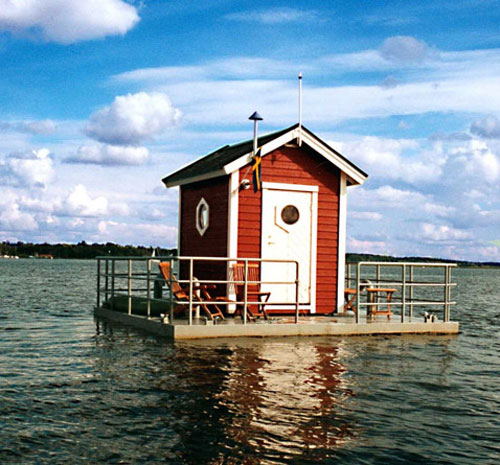
They too have “limited room service” – go figure. But at least you get to sleep in your own little aquarium; except this time you’re in the aquarium and the fish are on the outside. Gives you a whole new level of respect for your goldfish.
Average Cost: $250-350
Amsterdam
Harbour Crane
Located in Harlingen, Amsterdam, this is just what it sounds: an operational harbour crane. It is located right on the quay, and inside is a luxury room for two. Its height varies with the sea levels, but can range from 17-49 metres high. And why on earth would you like to sleep in a crane? Well, the view is surprisingly spectacular. But the real reason: you get to jump in the cockpit and play with the fully operational crane! This is truly a toy for boys.

The same company also offers a converted lifeboat and lighthouse as alternate accommodations. They are generally booked up to five months in advance, so if flirting with the construction industry and playing with big toys is up your alley, book early.
Average Cost: $500
France
Hotel Everland
Like so many weird and wacky hotels, the Hotel Everland is installation art at its best. It is actually a mobile hotel, but don’t get any pictures of trailer parks in your mind here: it uses its mobility to set up in some of the most amazing places. Currently it is in Paris, France, and you have to see the site to believe where it actually sits and what your view looks like.
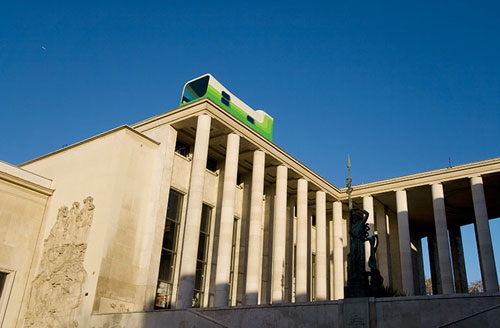
Check in and check out times are pretty stringent though (no sleeping in and lounging about in your jammies for the morning) – it is actually a museum by day.
Average Cost: unknown, but I suspect if you have to ask you may be barking up the wrong tree
Austria
Das Park Hotel
Here’s another one for the budget-minded: you get to sleep in a giant concrete sewage pipe. Yup, you read it right. Initially I wondered why anybody would sleep in such an atrocity, and after researching the piece I still feel that way. The only saving grace I could see is its location: on the Danube, near Linz.
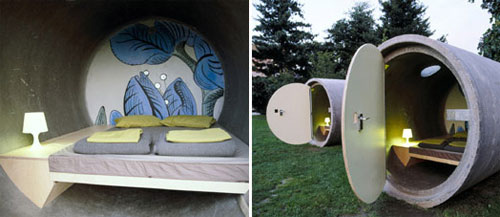
The sewage pipe-rooms are located on a campground, and the facilities are basic at best. Washrooms are a short walk away.
What I can’t get over is, if you want to stay on a campground, why not just bring a tent?!
Average Cost: (this is the clincher for a budget traveler and possibly makes the whole idea okay): Pay as you wish system
New Zealand
The Hobbit Motel, Woodlyn Park
If you are a Lord of the Rings fan, you may be rushing to Otorohanga, New Zealand to stay here. The world’s first (first? There are more?) Hobbit Motel is located in Woodlyn Park, and is an exact replica of the hobbit homes you saw in the movies. The inside is considerably more contemporary (which actually detracts from the idea in of staying in hobbit accommodations in my mind), but at least it’s comfortable and you don’t have to crouch everywhere you go.
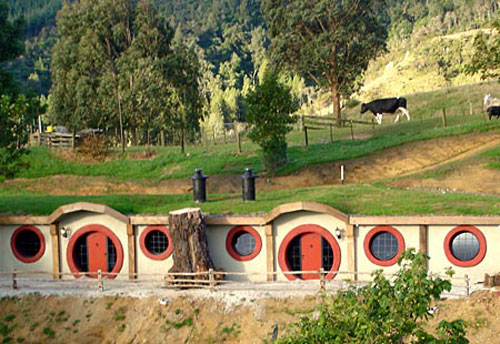
At Woodlyn Park, you can also stay in a plane, a ship, or a train if hobbits aren’t your thing.
Average Cost: $135
Panama
Canopy Tower Ecolodge and Observatory
This spectacular hotel is in Panama City, Panama and if you are a nature and bird-watching enthusiast this should send you into fits of ecstasy. Your accommodations take the form of an old radar tower and afford 360 degree views high over top of the rainforest. Your room is made up of a 30ft high dome, with an upper level bedroom full of windows, and a lower level living space perfect for observing birds high in the forest canopy.
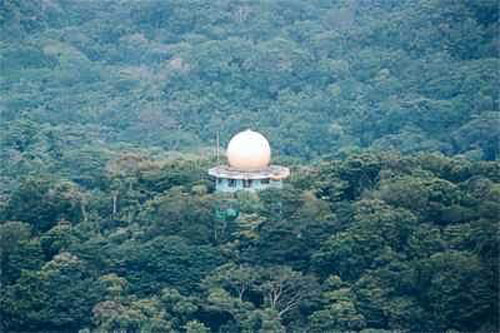
They do warn you to bring earplugs if you don’t wish the birds to be your alarm clock at first light.
Average Cost: $105-220
This is by no means a complete cross-section of the wonderful and bizarre places you can stay around the world. If none of these speak to you but you think there may be something wacky enough to get you to pack your bags, here are a few places to start looking:
This post powered by :

copyright - javaatsaindra.blogspot.com - OSC
Semua content dari blog ini bersifat open-source. Silahkan memperbanyak, menyebarluaskan, mencetak, dan memodifikasi asalkan tetap mencantumkan author dan alamat blog ini. Terimakasih. DONT BE A PLAGIATOR!!
- Copyright . 2008-2011 . Java[at]Saindra . OpenSourceContent
- Back To Top
- Home








